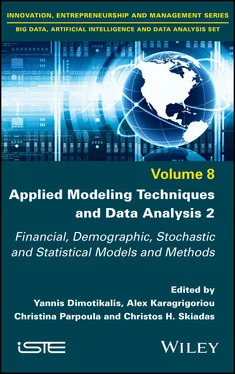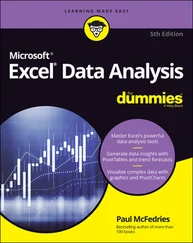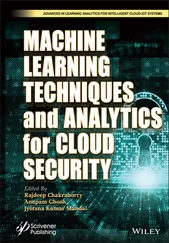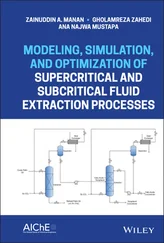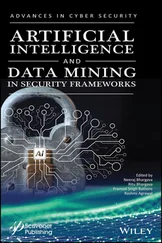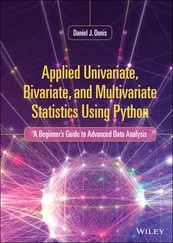Applied Modeling Techniques and Data Analysis 2
Здесь есть возможность читать онлайн «Applied Modeling Techniques and Data Analysis 2» — ознакомительный отрывок электронной книги совершенно бесплатно, а после прочтения отрывка купить полную версию. В некоторых случаях можно слушать аудио, скачать через торрент в формате fb2 и присутствует краткое содержание. Жанр: unrecognised, на английском языке. Описание произведения, (предисловие) а так же отзывы посетителей доступны на портале библиотеки ЛибКат.
- Название:Applied Modeling Techniques and Data Analysis 2
- Автор:
- Жанр:
- Год:неизвестен
- ISBN:нет данных
- Рейтинг книги:5 / 5. Голосов: 1
-
Избранное:Добавить в избранное
- Отзывы:
-
Ваша оценка:
- 100
- 1
- 2
- 3
- 4
- 5
Applied Modeling Techniques and Data Analysis 2: краткое содержание, описание и аннотация
Предлагаем к чтению аннотацию, описание, краткое содержание или предисловие (зависит от того, что написал сам автор книги «Applied Modeling Techniques and Data Analysis 2»). Если вы не нашли необходимую информацию о книге — напишите в комментариях, мы постараемся отыскать её.
Applied Modeling Techniques and Data Analysis 2 — читать онлайн ознакомительный отрывок
Ниже представлен текст книги, разбитый по страницам. Система сохранения места последней прочитанной страницы, позволяет с удобством читать онлайн бесплатно книгу «Applied Modeling Techniques and Data Analysis 2», без необходимости каждый раз заново искать на чём Вы остановились. Поставьте закладку, и сможете в любой момент перейти на страницу, на которой закончили чтение.
Интервал:
Закладка:
Table of Contents
1 Cover
2 Title Page Big Data, Artificial Intelligence and Data Analysis Set coordinated by Jacques Janssen Volume 8
3 Copyright First published 2021 in Great Britain and the United States by ISTE Ltd and John Wiley & Sons, Inc. Apart from any fair dealing for the purposes of research or private study, or criticism or review, as permitted under the Copyright, Designs and Patents Act 1988, this publication may only be reproduced, stored or transmitted, in any form or by any means, with the prior permission in writing of the publishers, or in the case of reprographic reproduction in accordance with the terms and licenses issued by the CLA. Enquiries concerning reproduction outside these terms should be sent to the publishers at the undermentioned address: ISTE Ltd 27-37 St George’s Road London SW19 4EU UK www.iste.co.uk John Wiley & Sons, Inc. 111 River Street Hoboken, NJ 07030 USA www.wiley.com © ISTE Ltd 2021 The rights of Yannis Dimotikalis, Alex Karagrigoriou, Christina Parpoula and Christos H. Skiadas to be identified as the authors of this work have been asserted by them in accordance with the Copyright, Designs and Patents Act 1988. Library of Congress Control Number: 2020951002 British Library Cataloguing-in-Publication Data A CIP record for this book is available from the British Library ISBN 978-1-78630-674-6
4 Preface
5 PART 1: Financial and Demographic Modeling Techniques PART 1 Financial and Demographic Modeling Techniques
1 Data Mining Application Issues in the Taxpayer Selection Process 1 Data Mining Application Issues in the Taxpayer Selection Process This chapter provides a data analysis framework designed to build an effective learning scheme aimed at improving the Italian Revenue Agency’s ability to identify non-compliant taxpayers, with special regard to self-employed individuals allowed to keep simplified registers. Our procedure involves building two C4.5 decision trees, both trained and validated on a sample of 8,000 audited taxpayers, but predicting two different class values, based on two different predictive attribute sets. That is, the first model is built in order to identify the most likely non-compliant taxpayers, while the second identifies the ones that are are less likely to pay the additional due tax bill. This twofold selection process target is needed in order to maximize the overall audit effectiveness. Once both models are in place, the taxpayer selection process will be held in such a way that businesses will only be audited if they are judged as worthy by both models. This methodology will soon be validated on real cases: that is, a sample of taxpayers will be selected according to the classification criteria developed in this chapter and will subsequently be involved in some audit processes.
1.1. Introduction 1.2. Materials and methods 1.3. Results 1.4. Discussion 1.5. Conclusion 1.6. References 2 Asymptotics of Implied Volatility in the Gatheral Double Stochastic Volatility Model 2.1. Introduction 2.2. The results 2.3. Proofs 2.4. References 3 New Dividend Strategies 3.1. Introduction 3.2. Model 1 3.3. Model 2 3.4. Conclusion and further results 3.5. Acknowledgments 3.6. References 4 Introduction of Reserves in Self-adjusting Steering of Parameters of a Pay-As-You-Go Pension Plan 4.1. Introduction 4.2. The pension system 4.3. Theoretical framework of the Musgrave rule 4.4. Transformation of the retirement fund 4.5. Conclusion 4.6. References 5 Forecasting Stochastic Volatility for Exchange Rates using EWMA 5.1. Introduction 5.2. Data 5.3. Empirical model 5.4. Exchange rate volatility forecasting 5.5. Conclusion 5.6. Acknowledgments 5.7. References 6 An Arbitrage-free Large Market Model for Forward Spread Curves 6.1. Introduction and background 6.2. Construction of a market with infinitely many assets 6.3. Existence, uniqueness and non-negativity 6.4. Conclusion and future works 6.5. References 7 Estimating the Healthy Life Expectancy (HLE) in the Far Past: The Case of Sweden (1751-2016) with Forecasts to 2060 7.1. Life expectancy and healthy life expectancy estimates 7.2. The logistic model 7.3. The HALE estimates and our direct calculations 7.4. Conclusion 7.5. References 8 Vaccination Coverage Against Seasonal Influenza of Workers in the Primary Health Care Units in the Prefecture of Chania 8.1. Introduction 8.2. Material and method 8.3. Results 8.4. Discussion 8.5. References 9 Some Remarks on the Coronavirus Pandemic in Europe 9.1. Introduction 9.2. Background 9.3. Materials and analyses 9.4. The first phase of the pandemic 9.5. Concluding remarks 9.6. References
6 PART 2: Applied Stochastic and Statistical Models and Methods 10 The Double Flexible Dirichlet: A Structured Mixture Model for Compositional Data 10.1. Introduction 10.2. The double flexible Dirichlet distribution 10.3. Computational and estimation issues 10.4. References 11 Quantization of Transformed Lévy Measures 11.1. Introduction 11.2. Estimation strategy 11.3. Estimation of masses and the atoms 11.4. Simulation results 11.5. Conclusion 11.6. References 12 A Flexible Mixture Regression Model for Bounded Multivariate Responses 12.1. Introduction 12.2. Flexible Dirichlet regression model 12.3. Inferential issues 12.4. Simulation studies 12.5. Discussion 12.6. References 13 On Asymptotic Structure of the Critical Galton-Watson Branching Processes with Infinite Variance and Allowing Immigration 13.1. Introduction 13.2. Invariant measures of GW process 13.3. Invariant measures of GWPI 13.4. Conclusion 13.5. References 14 Properties of the Extreme Points of the Joint Eigenvalue Probability Density Function of the Wishart Matrix 14.1. Introduction 14.2. Background 14.3. Polynomial factorization of the Vandermonde and Wishart matrices 14.4. Matrix norm of the Vandermonde and Wishart matrices 14.5. Condition number of the Vandermonde and Wishart matrices 14.6. Conclusion 14.7. Acknowledgments 14.8. References 15 Forecast Uncertainty of the Weighted TAR Predictor 15.1. Introduction 15.2. SETAR predictors and bootstrap prediction intervals 15.3. Monte carlo simulation 15.4. References 16 Revisiting Transitions Between Superstatistics 16.1. Introduction 16.2. From superstatistic to transition between superstatistics 16.3. Transition confirmation 16.4. Beck’s transition model 16.5. Conclusion 16.6. Acknowledgments 16.7. References 17 Research on Retrial Queue with Two-Way Communication in a Diffusion Environment 17.1. Introduction 17.2. Mathematical model 17.3. Asymptotic average characteristics 17.4. Deviation of the number of applications in the system 17.5. Probability distribution density of device states 17.6. Conclusion 17.7. References
7 List of Authors
8 Index
9 End User License Agreement
List of Illustrations
1 Chapter 1 Figure 1.1. Revenues distribution Figure 1.2. Tax claim distribution. For a color version of this figure, see www... Figure 1.3. Determining interesting and not interesting taxpayers. For a color ... Figure 1.4. Coercive procedures and tax claim. For a color version of this figu... Figure 1.5. The two models together Figure 1.6. First model statistics and confusion matrix Figure 1.7. Total tax claim and discounted tax claim. For a color version of th... Figure 1.8. Average total tax claim and discounted tax claim. For a color versi... Figure 1.9. Second model statistics and confusion matrix Figure 1.10. Coercive procedures’ rates. For a color version of this figure, se... Figure 1.11. Total tax claim. For a color version of this figure, see www.iste.... Figure 1.12. Average tax claim. For a color version of this figure, see www.ist... Figure 1.13. Coercive procedures’ rate. For a color version of this figure, see ... Figure 1.14. Models’ maximum and minimum collected tax. For a color version of ... Figure 1.15. Models’ approximation. For a color version of this figure, see www... Figure 1.16. Values of θ’ and θ” determining the best model. For a color versio...
Читать дальшеИнтервал:
Закладка:
Похожие книги на «Applied Modeling Techniques and Data Analysis 2»
Представляем Вашему вниманию похожие книги на «Applied Modeling Techniques and Data Analysis 2» списком для выбора. Мы отобрали схожую по названию и смыслу литературу в надежде предоставить читателям больше вариантов отыскать новые, интересные, ещё непрочитанные произведения.
Обсуждение, отзывы о книге «Applied Modeling Techniques and Data Analysis 2» и просто собственные мнения читателей. Оставьте ваши комментарии, напишите, что Вы думаете о произведении, его смысле или главных героях. Укажите что конкретно понравилось, а что нет, и почему Вы так считаете.
